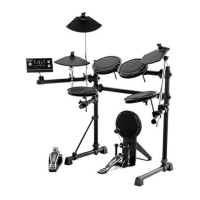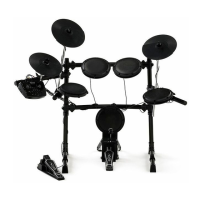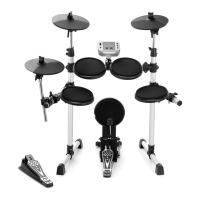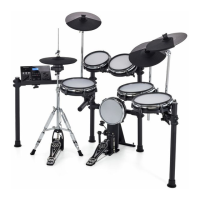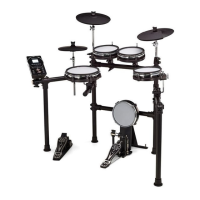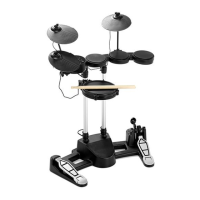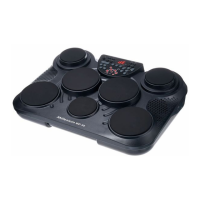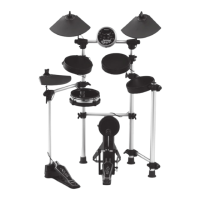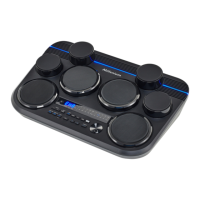Do you have a question about the thomann Millenium MPS-600 and is the answer not in the manual?
Overview of symbols and signal words used in the user manual.
Defines the proper usage of drum modules for converting digital trigger signals.
Safety warning regarding hazards for children, including choking and electrical dangers.
Warning about potential hearing impairment from high volume levels.
Guidelines for safe operation, avoiding liquids, dirt, and vibrations.
Precautions for connecting and using the external power supply to prevent damage.
Instructions for setting up and connecting drum pads and pedals.
Steps to connect the power adapter to the device and a wall outlet.
Guide for connecting amplifiers or powered speakers to the OUTPUT sockets.
Instructions for connecting MIDI devices and MP3 players.
Illustrates and identifies controls on the front panel of the MPS-600.
Details the LCD display and PAGE +/- buttons for menu navigation.
Explains volume controls, parameter adjustment buttons, and the jog wheel.
Details buttons for Click, Mixer, Menu, Part Mute, and Record functions.
Describes buttons for Quick Record, Play/Stop, Kit, Utility, and Song menus.
Details pad select buttons with LEDs and the function of the [RIM] button.
Illustrates the rear panel of the MPS-600 e-drum module.
Explains power, USB, MIDI, Pad, Headphone, and AUX connections.
Guide to quickly start using the device, including switching on/off and playing demo songs.
Instructions on selecting kits, playing songs, muting parts, and using the click function.
Explains the function of pads, triggers, and how they produce sounds (voices).
Details the components and information displayed on the LCD screen.
Explains how to store songs in internal memory and on an SD card.
Information on drum kits, including preset and user-created kits.
Step-by-step guide to selecting and modifying drum kits.
How to program pads to play patterns or songs.
Using preset kits as a basis for user kits and saving them.
How to save current or all user kits to an SD card.
How to adjust overall kit volume, accompaniment track, and click volume.
How to set individual trigger volumes and adjust song track volumes.
Guide to playing and modifying songs, including song structure.
How to start song playback and adjust individual song parts.
How to mute individual parts of a song during playback.
Steps to mute drum parts or other selected parts and MIDI channels.
Instantly record a drum track without pre-settings.
Using MIDI devices to play or feed new songs into the module.
How to turn the click function on/off and access click settings.
Accessing the utility menu to adjust parameters and reset to factory defaults.
Adjusting pad settings like sensitivity, threshold, and trigger curves.
Adjusting reverb effects and the 4-band equalizer.
Configuring MIDI settings like Local, SoftThru, and GM Mode.
Saving all user settings to an SD card.
Resetting parameters and memory to factory defaults.
Information on using SD cards for playing MIDI files, loading, and saving data.
Steps to insert an SD card and play MIDI files.
How to load MIDI files from an SD card into the module's memory.
Instructions on how to format an SD card for use with the module.
Lists number of voices, drum kits, sequencer capabilities, and play modes.
Lists available connections like USB, MIDI, AUX, and power adapter specifications.
Recommended methods and precautions for cleaning the device.
Guidelines for environmentally friendly disposal of packaging and the old device.
Table showing the assignment of triggers and pads to MIDI notes.
List of all 40 pre-installed drum kit names and their numbers.
A comprehensive list of all available voices (sounds) with their display and full names.
A list of available songs categorized by pattern loop, 1 shot, percussion loop, and HIT.
Overview of symbols and signal words used in the user manual.
Defines the proper usage of drum modules for converting digital trigger signals.
Safety warning regarding hazards for children, including choking and electrical dangers.
Warning about potential hearing impairment from high volume levels.
Guidelines for safe operation, avoiding liquids, dirt, and vibrations.
Precautions for connecting and using the external power supply to prevent damage.
Instructions for setting up and connecting drum pads and pedals.
Steps to connect the power adapter to the device and a wall outlet.
Guide for connecting amplifiers or powered speakers to the OUTPUT sockets.
Instructions for connecting MIDI devices and MP3 players.
Illustrates and identifies controls on the front panel of the MPS-600.
Details the LCD display and PAGE +/- buttons for menu navigation.
Explains volume controls, parameter adjustment buttons, and the jog wheel.
Details buttons for Click, Mixer, Menu, Part Mute, and Record functions.
Describes buttons for Quick Record, Play/Stop, Kit, Utility, and Song menus.
Details pad select buttons with LEDs and the function of the [RIM] button.
Illustrates the rear panel of the MPS-600 e-drum module.
Explains power, USB, MIDI, Pad, Headphone, and AUX connections.
Guide to quickly start using the device, including switching on/off and playing demo songs.
Instructions on selecting kits, playing songs, muting parts, and using the click function.
Explains the function of pads, triggers, and how they produce sounds (voices).
Details the components and information displayed on the LCD screen.
Explains how to store songs in internal memory and on an SD card.
Information on drum kits, including preset and user-created kits.
Step-by-step guide to selecting and modifying drum kits.
How to program pads to play patterns or songs.
Using preset kits as a basis for user kits and saving them.
How to save current or all user kits to an SD card.
How to adjust overall kit volume, accompaniment track, and click volume.
How to set individual trigger volumes and adjust song track volumes.
Guide to playing and modifying songs, including song structure.
How to start song playback and adjust individual song parts.
How to mute individual parts of a song during playback.
Steps to mute drum parts or other selected parts and MIDI channels.
Instantly record a drum track without pre-settings.
Using MIDI devices to play or feed new songs into the module.
How to turn the click function on/off and access click settings.
Accessing the utility menu to adjust parameters and reset to factory defaults.
Adjusting pad settings like sensitivity, threshold, and trigger curves.
Adjusting reverb effects and the 4-band equalizer.
Configuring MIDI settings like Local, SoftThru, and GM Mode.
Saving all user settings to an SD card.
Resetting parameters and memory to factory defaults.
Information on using SD cards for playing MIDI files, loading, and saving data.
Steps to insert an SD card and play MIDI files.
How to load MIDI files from an SD card into the module's memory.
Instructions on how to format an SD card for use with the module.
Lists number of voices, drum kits, sequencer capabilities, and play modes.
Lists available connections like USB, MIDI, AUX, and power adapter specifications.
Recommended methods and precautions for cleaning the device.
Guidelines for environmentally friendly disposal of packaging and the old device.
Table showing the assignment of triggers and pads to MIDI notes.
List of all 40 pre-installed drum kit names and their numbers.
A comprehensive list of all available voices (sounds) with their display and full names.
A list of available songs categorized by pattern loop, 1 shot, percussion loop, and HIT.
